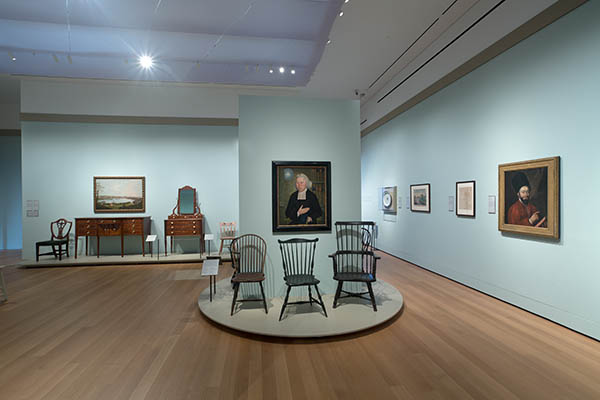
This September, I attended a symposium that kicked off an exciting new exhibit at Yale University’s Art Gallery: Art and Industry in Early America, Rhode Island Furniture 1650 to 1830. The show represents painstaking research by Patricia A. Kane and her colleagues: Dennis Carr, Nancy Goyne Evans, Jennifer N. Johnson and Gary R. Sullivan. A decade and a half of research went into this exhibit with some interesting outcomes. Each of these historians brought something to the exhibition.
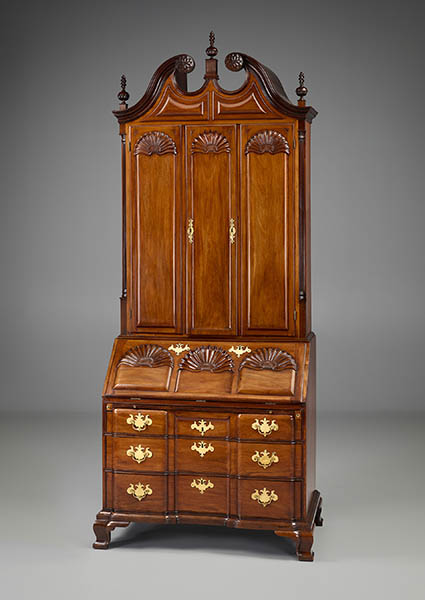
The question that I am sure you’re asking is why is Rhode Island furniture relevant today? The modern state of Rhode Island is the amalgamation of two British colonies founded in the 1600s. In honor of this, the state’s official name is Rhode Island and Providence Plantations; the smallest state boasts the longest name. The founders gravitated there to find religious and ideological freedom. Theologian Roger Williams was banished from the Massachusetts Bay Colony in 1636 for spreading “new and dangerous ideas” and settled on Narragansett Bay, founding the city of Providence. Other religious dissenters settled on the north end of Aquidneck Island in1638, founding Portsmouth; mavericks from this group traveled 20 miles south to found Newport shortly after.
What was called “the point” in the northern part of Newport became the equivalent of an eighteenth century flash mob of ship carpenters, joiners and, most importantly to this narrative, cabinetmakers. Newport had a fine deepwater harbor so attracted a newly emerging merchant class. They needed ships, homes and furniture for these homes, which required a prodigious number of woodworkers. As you can see from the map illustration, there was no lack of woodworkers in Newport by the beginning of the eighteenth century.
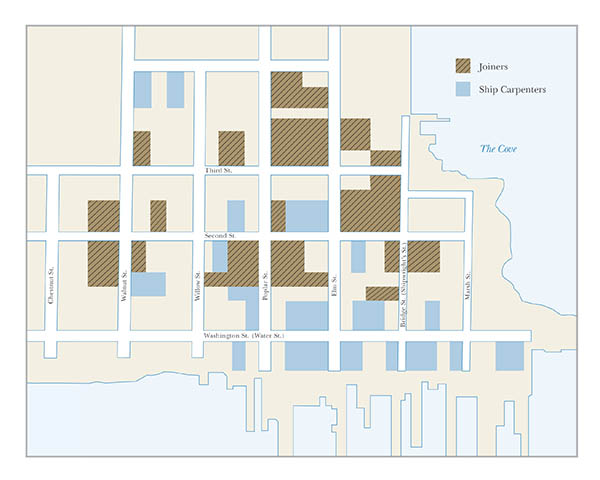
All of the towns in Rhode Island were destroyed between 1675-76 in King Phillip’s War, a war with the local Native Americans. Newport, however, was spared for it was remote on the south end of Aquidneck Island. Because of this war, Rhode Island furniture from before 1676 is extremely rare. Newport’s woodworkers prospered replacing all the houses and furniture destroyed in King Philip’s War.
Woodworkers on the point were predominately Quakers, giving a heavy English influence to their style, but there was also influence from Dutch and French craftsman. Starting in 1624, the Dutch had settled the Hudson River Valley and trade with Rhode Island was only a short sail up Block Island Sound. A group of 48 French Huguenot Families immigrated in 1686, attracted by religious tolerance as a founding principle of the Rhode Island colonies.
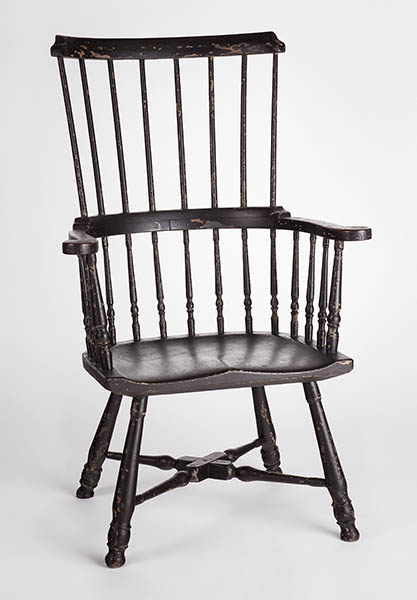
Two Quaker families important to Rhode Island cabinetmaking purchased lots on the point in 1724-25. Brothers Job and Christopher Townsend from Oyster Bay, New York, were cabinetmakers and set up separate shops. Daniel Goddard was a house carpenter. Daniel’s sons John and James Goddard apprenticed under Job Townsend and each married one of his daughters. Christopher’s son John Townsend also set up shop in Newport. For over a century, 20 descendants of these two families plied the woodworking trade from Newport, selling their furniture in the coastal trade as far as the West Indies.
John Goddard and the three Townsends worked in the Queen Anne and Chippendale styles and made furniture with a design developed in Rhode Island, the block front with the blocking capped with carved shells. The shells were alternately carved convex and concave to eye-catching effect. Further stylizing the claw and ball foot of cabriole legs by undercutting the talons was known in England and Ireland, but Rhode Island was the only place in the Colonies that incorporated this innovation. John Townsend did this to dramatic effect on a high chest in the photos. All but Job Townsend, who died in 1765, worked through the golden age of Rhode Island furniture, 1740 to 1790. Newport and Rhode Island in general developed an iconic furniture style, the vestiges of which can still be seen in high-end commercial furniture. That is why studying this furniture is well worth our time.
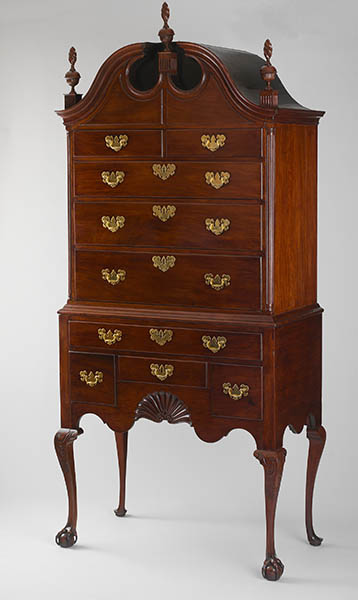
A big problem for museums and collectors of Colonial era furniture is attribution: where, and by whom was a piece made? This is called provenance, which literally means “place of origin or earliest known history.” A further problem is that cabinetmakers of that era often did not sign their work. Style and methods of work plays an important part in establishing provenance. Craftsman have subtle differences in their style and work methods. If you belong to a woodworking club, you can often look at a piece on the show-and-tell table and correctly say, “Joe made that,” without looking at the card next to it.
The problem is that today’s historians and dealers never saw any Colonial work fresh out of the shop. Any piece of furniture that is 200 to 300 years old is going to have had some repair and refinishing. In the twentieth century, style was a prime factor in attributing pieces. John Goddard is an excellent example of this method’s shortcomings. Many pieces attributed to him have now been unattributed.
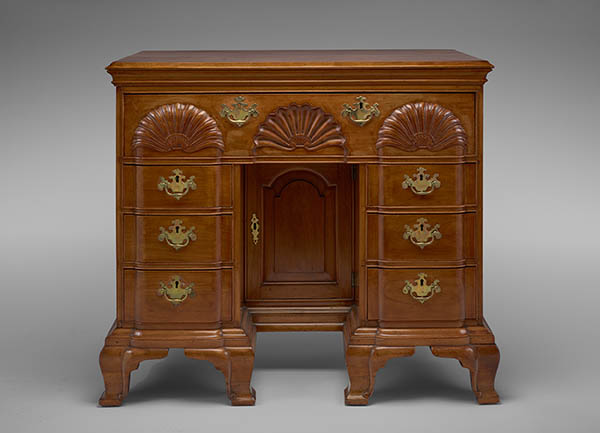
The type of wood used, especially the secondary woods used for backs, bottoms and drawer sides and backs, can help historians to say a piece was made in, say, Boston, Massachusetts, rather than Newport, Rhode Island. The problem with this method is that it can be very hard to identify one piece of newly cut, let alone centuries old, wood from another. Eastern cottonwood (Populus deltoides) and yellow poplar (Liriodendron tulipifera) are poster children for this phenomenon. Both are tight grained with great working properties. Both are chameleon woods that can be stained to look like much more expensive species. Left unfinished for 50-plus years (finishing the insides of cabinets and drawers is a post WWII happening), these two woods are difficult to tell apart with naked eye inspection.
A much more accurate method is to look at end grain under 10x magnification and compare it to macrophotographs. There are books and Internet sites with such photos. Understanding Wood by R. Bruce Hoadley is an excellent text to learn how to do this correctly and has a comprehensive folio of macrophotographs. Use of microscopic examination, as well, has become a valuable aid in furthering provenance. Historians are also now using dendrochronology, which microscopically analyzes individual growth rings down to the year they were laid down. Each growth ring has a fingerprint. It was used recently to rescue a piece of furniture at the Getty Museum from being labeled a fake to a 1580 original.
Finish is also an indicator. Owners often had pieces modified. An example in Philip Zimmerman’s opening keynote address was an a Rhode Island piece that the auction house described as an eighteenth century fall front desk with a bookcase that was added in the twentieth century. Analysis’s of the finish, however, indicated that the finish on both halves of the piece were identical and original, greatly increasing the piece’s provenance.
A long-established method in establishing provenance is ownership. If we know from an account book who purchased a piece of furniture from a given maker and we can trace this ownership through generations of the buyer’s family, attribution is much more assured. In the past, a historian had to travel to the maker and the owner’s towns to research probate and church records, but these records are increasingly on line. Genealogical sites are also much more sophisticated today. This makes research in general easier and finding the authenticity of less valuable works possible. All of these tools are changing thoughts about who build given pieces of furniture, as is the case with John Goddard.
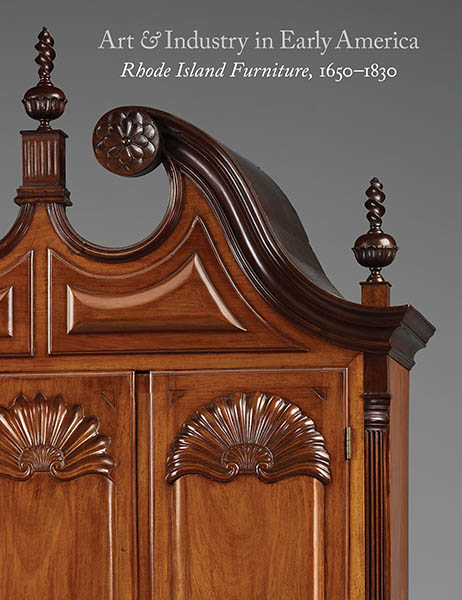
A really exciting outgrowth of the 15 years of research that Pat Kane and her colleagues put into the exhibit is the Rhode Island Furniture Archive, RIFA for short. This online database lists all of the known information, and in most cases has a photograph, on a huge body of Rhode Island Furniture. I have given the RIFA number in all of the photos in this article and encourage the reader to go to the database and see the goldmine of information that has been compiled. Type in rif plus the number. There is also a book, available from Yale University Art Gallery, which accompanies the exhibit that contains photos and gallery entries for all the furniture int eh exhibit.
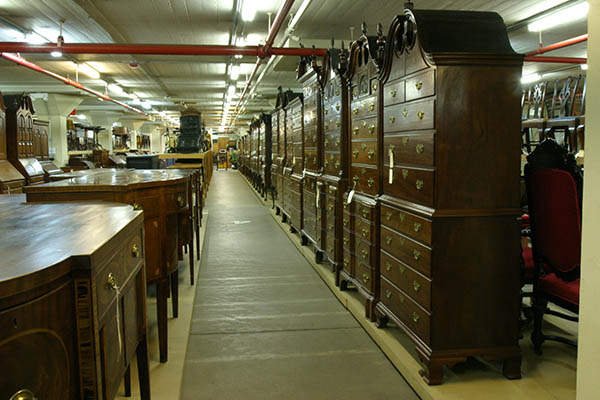
A parallel research tool is the Yale Furniture Study. This is a warehouse filled with more than 1100 pieces of American furniture. It is a working library where furniture can be studied in three dimensions. I spent two days there in 2008 photographing dovetail joints for the history section for my book: Woodworker’s Guide to Dovetails. The photo below of the dovetails in John Townsend’s high chest was taken there. Furniture study is open to anyone by prior arrangement and there is a public tour every Friday at 12:30 pm.
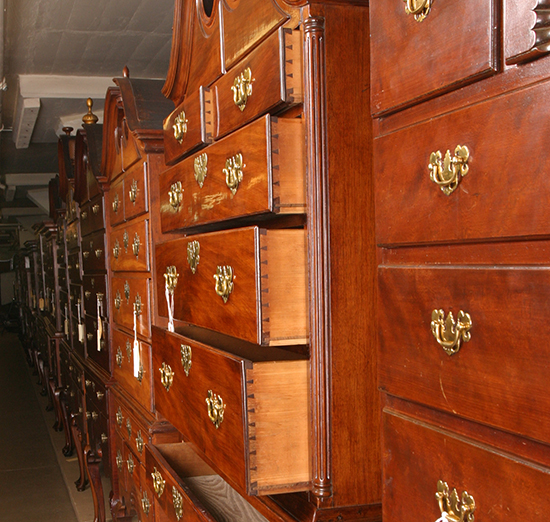
Philip Zimmerman’s Keynote Address, plus some interesting videos by contemporary woodworkers reproducing Colonial furniture, can be viewed at the Yale YouTube channel.
On a final note of why Rhode Island Furniture is important. The Kindel Furniture Company of Grand Rapids, Michigan makes a line of furniture that are reproductions of pieces in Winterthur Museum’s collection. They make a reproduction of a Desk and Bookcase similar to the one pictured at the top of this article. This one resides at Winterthur and is RIF1229 in the Yale Archive. The retail price of the Kindel reproduction is $87,290. After the astounding $12.1 million hammer price for RIF1232 at Christie’s Auction House in 1989, Kindel received 87 orders for their reproduction, thus employing a great many woodworkers.
People rave every time Christoph Von Dohnányi leads the Cleveland Orchestra in another performance/interpretation of Beethoven, and building reproductions is just as relevant. Furniture is performance art!





